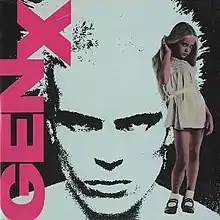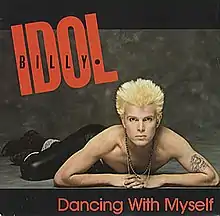Dancing with Myself
"Dancing with Myself" is a song by the punk rock band Gen X, first commercially released in the United Kingdom in October 1980, where it reached number 62 on the UK Singles Chart. It was remixed and re-released by the band's singer/frontman Billy Idol as a solo artist in the United States in 1981, where the song reached number 27 on the US Billboard Hot Dance Club Play chart. Nouvelle Vague covered the number in 2006 and released it on their album, Bande à Part.
| "Dancing with Myself" | |
|---|---|
 | |
| Single by Gen X | |
| from the album Kiss Me Deadly | |
| Released | October 1980 |
| Genre | |
| Length | 3:45 (album version) 3:30 (7" version) 4:06 (12" version) |
| Label | Chrysalis |
| Songwriter(s) |
|
| Producer(s) | Keith Forsey |
| "Dancing with Myself" | ||||
|---|---|---|---|---|
 | ||||
| Single by Billy Idol | ||||
| from the album Don't Stop | ||||
| Released | March 1981[3] | |||
| Recorded | 1980 (remixed in 1981) | |||
| Genre | ||||
| Length | 4:50 (album version) 3:19 (single version) 6:05 (12" version) | |||
| Label | Chrysalis | |||
| Songwriter(s) |
| |||
| Producer(s) | Keith Forsey | |||
| Billy Idol singles chronology | ||||
| ||||
| Music video | ||||
| "Dancing with Myself" on YouTube | ||||
Theme
The inspiration for the song occurred during a tour of Japan by the English post-punk band Generation X in mid-1979, when its vocalist/frontman Billy Idol and its bassist Tony James were struck by the sight of the young crowd in a Tokyo discotheque dancing with their own reflections in walled mirrors rather than with one another.[6]
Production
The song was written and first recorded by Generation X during demo sessions in mid-1979 at Olympic Studios in West London (this demo-recording was first commercially released retrospectively on the long-player K.M.D.-Sweet Revenge (1998)).[7] After that band had split later in that year, Idol and James re-branded the act as Gen X, and in production sessions with Keith Forsey for a new long-player at AIR Studios in London in mid-1980, the song was re-recorded for commercial release as a single. The guitar parts of the song were a mix of the playing of three guitarists with distinctively differing styles, viz. Steve New playing the lead, Steve Jones playing rhythm, with another layer being added by Danny Kustow.[8] On commercial sales in October 1980 as a pre-release single from the new band's forthcoming long-player Kiss Me Deadly (1981), "Dancing with Myself" was a retail failure, reaching only number 62 in the UK Singles Chart.
In 1981, Idol, now a solo artist after Gen X had broken up, had Forsey remix the record for its release as a single in the United States, fading down the guitar(s) and bass tracks from their dominance in the 1980 UK release and accentuating the vocal and percussion tracks, to produce a more rhythmic sound for the American commercial market. It became his first hit single in the United States and launched his career there, two versions being issued: the 3:20 single version (which was later included on Idol's 11 of the Best compilation) and the 4:50 extended version that appeared on Idol's Don't Stop EP.
Music video
For the 1981 United States single release a music video for use on the newly launched MTV was made, directed by Tobe Hooper, with Idol in a scenario drawn from the 1971 cinema film The Omega Man, playing a lone figure in a post-apocalyptic cityscape besieged upon a skyscraper rooftop by partying mutant street-waifs.[7]
Cover art
The portrait image of Idol on the cover of the 1980 release was photographed by Iain McKell.
Formats and track listings
7″: Chrysalis – CHS 2444 (UK)
- "Dancing with Myself" (3:30)
- "Ugly Rash" (4:30)
12″: Chrysalis – CHS 12 2444 (UK)
- "Dancing with Myself" (4:06)
- "Loopy Dub" (5:08)
- "Ugly Dub" (3:05)
12″ Chrysalis – CHS 2488 (45 rpm)
- "Dancing with Myself"
- "Untouchables"
- "Rock On"
- "King Rocker" (produced by Ian Hunter)
7″: Chrysalis – CHS 2488 (US)
- "Dancing with Myself" (3:19) [Labelled as "Billy Idol featuring Generation X"]
- "Happy People" (4:23)
7″: Chrysalis – IDOL 1 (UK – 1983)
- "Dancing with Myself" (3:19) [Labelled as "Billy Idol featuring Generation X"]
- "Love Calling (Dub)" (5:33)
12″: Chrysalis – IDOLX 1 (UK – 1983)
- "Dancing with Myself" (6:05) [Labelled as "Billy Idol featuring Generation X"]
- "Love Calling (Dub)" (5:33)
- "White Wedding" (8:20)
- "Hot in the City" (5:20)
- "White Wedding" is the 12" Shotgun mix, but not labelled as such.
Charts
Gen X version
| Chart (1980) | Peak position |
|---|---|
| UK Singles Chart[9] | 62 |
Billy Idol version
| Chart (1981) | Peak position |
|---|---|
| U.S. Billboard Hot Dance Club Play[10] | 27 |
| U.S. Billboard Bubbling Under Hot 100 Singles | 102 |
| Chart (1983) | Peak position |
| RIANZ New Zealand Singles Chart | 9 |
| Canada Top 50 Singles (RPM) | 39 |
Appearances in popular culture
- Swedish rock-reggae band Dag Vag released a Swedish version of the song called "Dansar med mig själv" on their fourth LP 7 lyckliga elefanter in 1982.
- Belgian rock band De Kreuners released a Dutch version of the song called "Ik dans wel met mezelf" in 1982.
- Used in Can’t Buy Me Love (1987 film).[11]
- In one episode of Beavis and Butt-Head, the titular duo watched the music video of this song and commented about it.
- A cover version by Blink-182 was featured on the compilation album Before You Were Punk[12] and on Taylor Steele’s Loose Change film soundtrack.
- Used in the soundtrack of Gia (1998).[13]
- A cover version by the Donnas was used in Mean Girls (2004) soundtrack,[14] as well as the episode "God U." from the 2023 series Gen V.
- In 2019, the song was re-arranged and covered by Postmodern Jukebox featuring Chloe Feoranzo. The video has more than two million views on YouTube.[15]
References
- Ruhlmann, William. "Don't Stop - Billy Idol | Songs, Reviews,Credits". AllMusic. Retrieved 15 August 2020.
- Osterberg, Christopher (29 June 2022). "A survivor of rock'n'roll's extreme lifestyle". The Budapest Times. Retrieved 20 September 2022.
"Dancing with Myself" defined him as a member of the glam rock contingent made popular by music videos in that decade.
- "Billy Idol and Gen X - Dancing with Myself". 45cat.com.
- Brennan, Collin (30 June 2016). "Civil Twilight turn Billy Idol's "Dancing With Myself" into a sparse, understated ballad – listen". Consequence of Sound. Retrieved 15 August 2020.
- Christgau, Robert (1990). "I". Christgau's Record Guide: The '80s. Pantheon Books. ISBN 0-679-73015-X. Retrieved 20 February 2020 – via robertchristgau.com.
- Billy Idol explaining the song's origin, Billy Idol Unplugged (2001), (1.11. mins).
- Idol, Billy (2014). Dancing with Myself. Simon & Schuster.
- Interview with Tony James, April 2002, for the Generation X Anthology (2003).
- Roberts, David (2006). British Hit Singles & Albums (19th ed.). London: Guinness World Records Limited. p. 224. ISBN 1-904994-10-5.
- "Billy Idol | Awards". AllMusic. Archived from the original on 18 July 2016. Retrieved 20 August 2019.
- "Can't Buy Me Love (1987)". IMDb. Retrieved 13 August 2022.
- ""Before You Were Punk [1997] - Various Artists | Songs, Reviews, Credits | AllMusic". AllMusic. Retrieved 17 June 2020.
- "Gia (1998) Soundtracks". IMDb. Retrieved 20 August 2019.
- "Mean Girls (2004) Soundtracks". IMDb. Retrieved 20 August 2019.
- "Dancing With Myself - Postmodern Jukebox Billy Idol Cover ft. Chloe Feoranzo". YouTube. Archived from the original on 15 December 2021. Retrieved 14 November 2019.